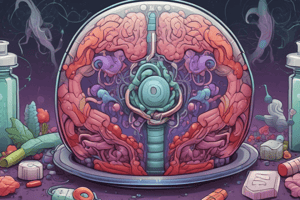Podcast
Questions and Answers
Which of the following polymixins is characterized by high systemic toxicity and topical application?
Which of the following polymixins is characterized by high systemic toxicity and topical application?
- Bacitracin
- Colistin
- Polymyxin (correct)
- Penicillin
What is the primary mode of action of amantadine?
What is the primary mode of action of amantadine?
- Preventing the entry of virus via endocytosis
- Inhibiting the release of viral genome
- Preventing the budding of new virions
- Inhibiting the M2 ion channel and raising the pH of endosome (correct)
Which of the following antibiotics is primarily used against multiresistant Staphylococci (MRSA) infections?
Which of the following antibiotics is primarily used against multiresistant Staphylococci (MRSA) infections?
- Colistin
- Vancomycin (correct)
- Polymyxin
- Bacitracin
What is the main mode of action of oseltamivir (Tamiflu)?
What is the main mode of action of oseltamivir (Tamiflu)?
What is the primary characteristic of viruses?
What is the primary characteristic of viruses?
What is the name of the virus that is an example of an RNA virus?
What is the name of the virus that is an example of an RNA virus?
What is the primary mechanism of action of acyclovir, valomaciclovir, and valacyclovir?
What is the primary mechanism of action of acyclovir, valomaciclovir, and valacyclovir?
What is the common side effect of zidovudine (AZT) treatment?
What is the common side effect of zidovudine (AZT) treatment?
Which immune cells are primarily infected by HIV?
Which immune cells are primarily infected by HIV?
What is the role of interferons in anti-viral therapy?
What is the role of interferons in anti-viral therapy?
What is the primary target of topical acyclovir application?
What is the primary target of topical acyclovir application?
What is the mechanism of action of zidovudine (AZT) in HIV treatment?
What is the mechanism of action of zidovudine (AZT) in HIV treatment?
What is the primary mechanism of action of Enfuvirtide in HIV treatment?
What is the primary mechanism of action of Enfuvirtide in HIV treatment?
Which of the following side effects is NOT associated with Enfuvirtide treatment?
Which of the following side effects is NOT associated with Enfuvirtide treatment?
What is the target of HIV treatment that prevents the conversion of RNA into cDNA?
What is the target of HIV treatment that prevents the conversion of RNA into cDNA?
Which of the following HIV treatments disrupts new capsid assembly?
Which of the following HIV treatments disrupts new capsid assembly?
What is the primary mechanism of action of Abacavir in HIV treatment?
What is the primary mechanism of action of Abacavir in HIV treatment?
What is the primary mechanism of action of Efavirenz in HIV treatment?
What is the primary mechanism of action of Efavirenz in HIV treatment?
What is the potential side effect of timpranavir?
What is the potential side effect of timpranavir?
Bacitracin is primarily used for treating deep tissue infections.
Bacitracin is primarily used for treating deep tissue infections.
All viruses are composed of DNA in a protein coat.
All viruses are composed of DNA in a protein coat.
Oseltamivir (Tamiflu) inhibits the activity of viral reverse transcriptase.
Oseltamivir (Tamiflu) inhibits the activity of viral reverse transcriptase.
Polymixins are absorbed by the GI tract when administered topically.
Polymixins are absorbed by the GI tract when administered topically.
Vancomycin is primarily used for treating superficial infections.
Vancomycin is primarily used for treating superficial infections.
Amantadine prevents the release of vRNA genome by inhibiting M2 ion channel.
Amantadine prevents the release of vRNA genome by inhibiting M2 ion channel.
Valacyclovir is used to treat Epstein Barr-Virus through topical application.
Valacyclovir is used to treat Epstein Barr-Virus through topical application.
Ganciclovir is used to treat Herpes simplex/zoster through oral administration.
Ganciclovir is used to treat Herpes simplex/zoster through oral administration.
Zidovudine (AZT) is a thymidine analogue that inhibits viral DNA polymerase.
Zidovudine (AZT) is a thymidine analogue that inhibits viral DNA polymerase.
Interferons are used to inhibit viral DNA synthesis.
Interferons are used to inhibit viral DNA synthesis.
CD4+ T lymphocytes are primarily infected by HIV due to the CXCR5/CD4 complex.
CD4+ T lymphocytes are primarily infected by HIV due to the CXCR5/CD4 complex.
HIV is a DNA virus that requires reverse transcription to integrate into the host genome.
HIV is a DNA virus that requires reverse transcription to integrate into the host genome.
Enfurvitide prevents the conversion of RNA into cDNA.
Enfurvitide prevents the conversion of RNA into cDNA.
Abacavir is a non-nucleoside reverse transcriptase inhibitor.
Abacavir is a non-nucleoside reverse transcriptase inhibitor.
Efavirenz is used to prevent viral entry into the cell.
Efavirenz is used to prevent viral entry into the cell.
HIV treatment targeting CXCR5/4 receptors prevents fusion of viral capsid with plasma membrane.
HIV treatment targeting CXCR5/4 receptors prevents fusion of viral capsid with plasma membrane.
Protease inhibition prevents the conversion of RNA into cDNA.
Protease inhibition prevents the conversion of RNA into cDNA.
Enfurvitide is used to prevent the integration of HIV genome into host genome.
Enfurvitide is used to prevent the integration of HIV genome into host genome.
Timpranavir is a drug that is used to treat multiresistant Staphylococci (MRSA) infections.
Timpranavir is a drug that is used to treat multiresistant Staphylococci (MRSA) infections.
Flashcards are hidden until you start studying
Study Notes
Influenza Clinical Trial Drugs
- Inhibition of DNA synthesis: acyclovir, valomaciclovir, and valacyclovir inhibit viral DNA polymerase.
- Topical application (acyclovir) against herpes simplex/zoster, varicella zoster.
- Oral administration (valaciclovir and ganciclovir) against Epstein-Barr virus.
- Minimal side effects.
HIV Treatment
- Blocking entry: targeting cell surface receptors CXCR5/4, which is required for virus entry.
- Preventing fusion of viral capsid with plasma membrane: e.g. enfurvitide.
- SIDE EFFECTS: CNS, metabolic, and GI effects.
- Preventing hostile take-over: preventing conversion of RNA into cDNA through inhibition of reverse transcriptase.
- Examples: abacavir (nucleoside) or efavirenz (non-nucleoside).
- SIDE EFFECTS: GI disturbances, musculoskeletal and dermatological effects, blood disorders, liver damage.
- Inhibition of integration into host genome.
- Preventing further transmission: disrupting new capsid assembly through protease inhibition.
- Examples: tipranavir.
- SIDE EFFECTS: GI disturbances, musculoskeletal and dermatological effects, blood disorders, liver damage.
Anti-Viral Therapy
- VIRUSES: originally described as ‘mobile genes’ consisting of DNA or RNA in a protein coat.
- Examples: DNA virus (Herpes Simplex Virus - HSV), RNA virus (Human Immunodeficiency Virus - HIV).
- Parasitic mode of action.
- Preventing entry: preventing viral “uncoating” and release of vRNA genome.
- Examples: amantadine.
- Preventing budding of new virions: inhibiting activity of viral neuraminidase enzyme.
- Examples: oseltamivir (Tamiflu).
Antibiotic Resistance
- POLYMIXINS: topical application, not absorbed by GI tract, high systemic toxicity.
- BACITRACIN: topical application, mainly used for superficial infections.
- VANCOMYCIN: oral and injection, bacteriocidal, main use is against multiresistant Staphylococci (MRSA) infection.
- Antibiotic resistance is a major threat, comparable to climate change.
- WHO Essential Medicines List.
Studying That Suits You
Use AI to generate personalized quizzes and flashcards to suit your learning preferences.




